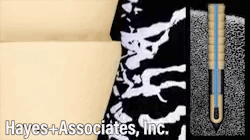In a decision handed down by the U.S. Court of Appeals for the Federal Circuit on January 16, 2013, an $85 million jury verdict over patent infringement against Arthrex, Inc., overturned in June 2011 by a lower court in Oregon, was reinstated in favor of Smith & Nephew, Inc.
Research undertaken by a team at Hayes + Associates, Inc. played a pivotal role in Smith & Nephew’s original victory, in which a jury found in favor of the company’s allegation that Arthrex was fully aware of steps used by its anchoring devices, marketed for use in shoulder surgeries, that were similar to those covered by Smith & Nephew’s patent. In 2011, Wilson C. Hayes, Ph.D., president of H+A, and his associates conducted a series of experiments in the company’s Corvallis, Oregon laboratory demonstrating that Arthrex suture anchors Bio-SutureTak, PEEKSutureTak, PushLock and Bio-PushLock violated a patent exclusively licensed to Smith & Nephew.
As reported by Mass Device (www.massdevice.com), a medical device industry Web site, the case, first filed in 2004, hinged on the interpretation of “lodging” and “ready to secure tissue” from the patent language. While Smith & Nephew maintained that the language describes a surgical anchor with resilience sufficient to keep it in the bone hole until it was tensioned, Arthrex argued that the anchor must be able to remain in place during the entire surgical procedure. U.S. District Court Judge Michael Mosman agreed with Arthrex in what was the third trial of the case.
The decision detailing the revival of the 2011 verdict stated that the court found “no support in the intrinsic record to require the ‘lodging’ to ’withstand all the forces of surgery’": In other words, the surgeon’s tug, while possibly necessary to complete the surgery, is not part of what is claimed. . . . Nothing in the claim language, the prosecution history, or our precedent suggests that lodging must be sufficient to withstand all the forces of surgery. Instead, lodging, as claimed, only relates to how the anchor stays in place after being initially pressed into the bone. Thus the court erred in construing the claims to require lodging to be sufficient to withstand all the forces of surgery.
In overturning the Oregon court’s decision, the Federal Circuit court sends the case back for reconsideration by Judge Mosman.


